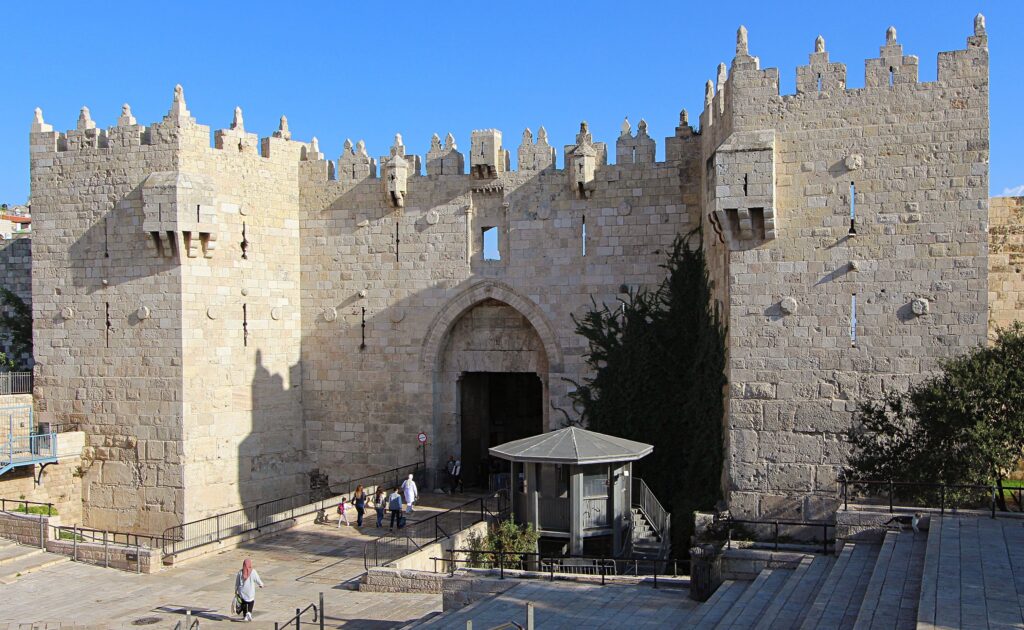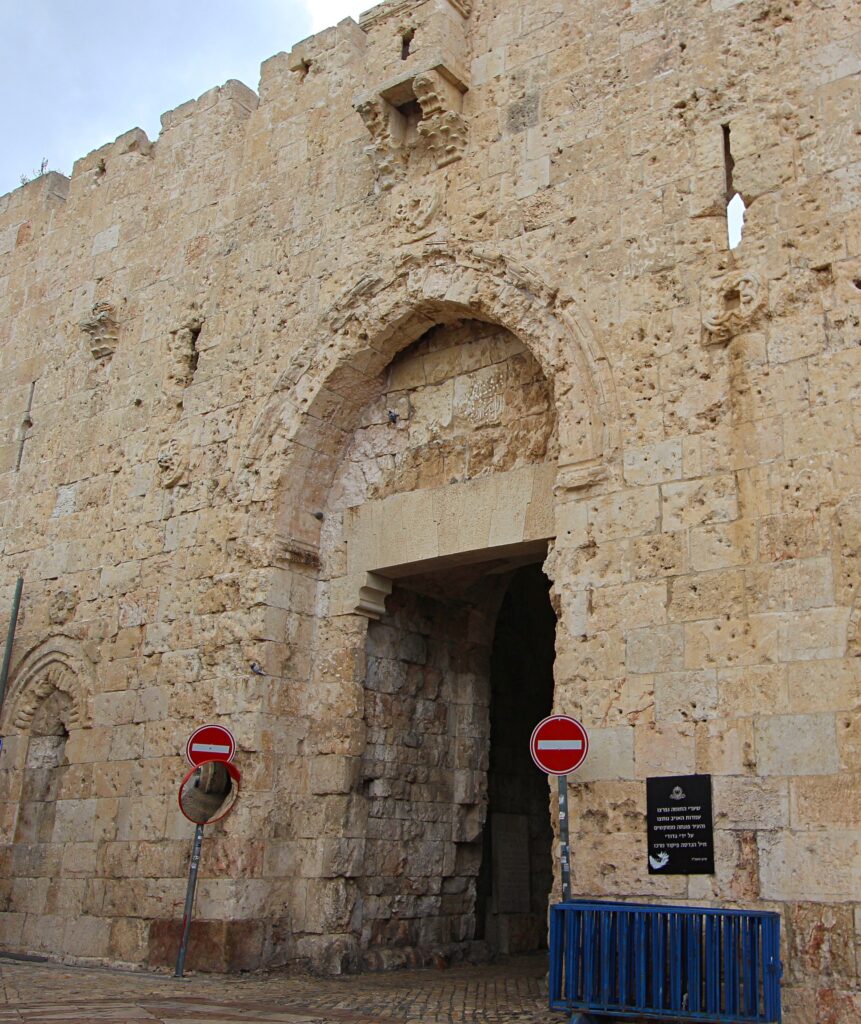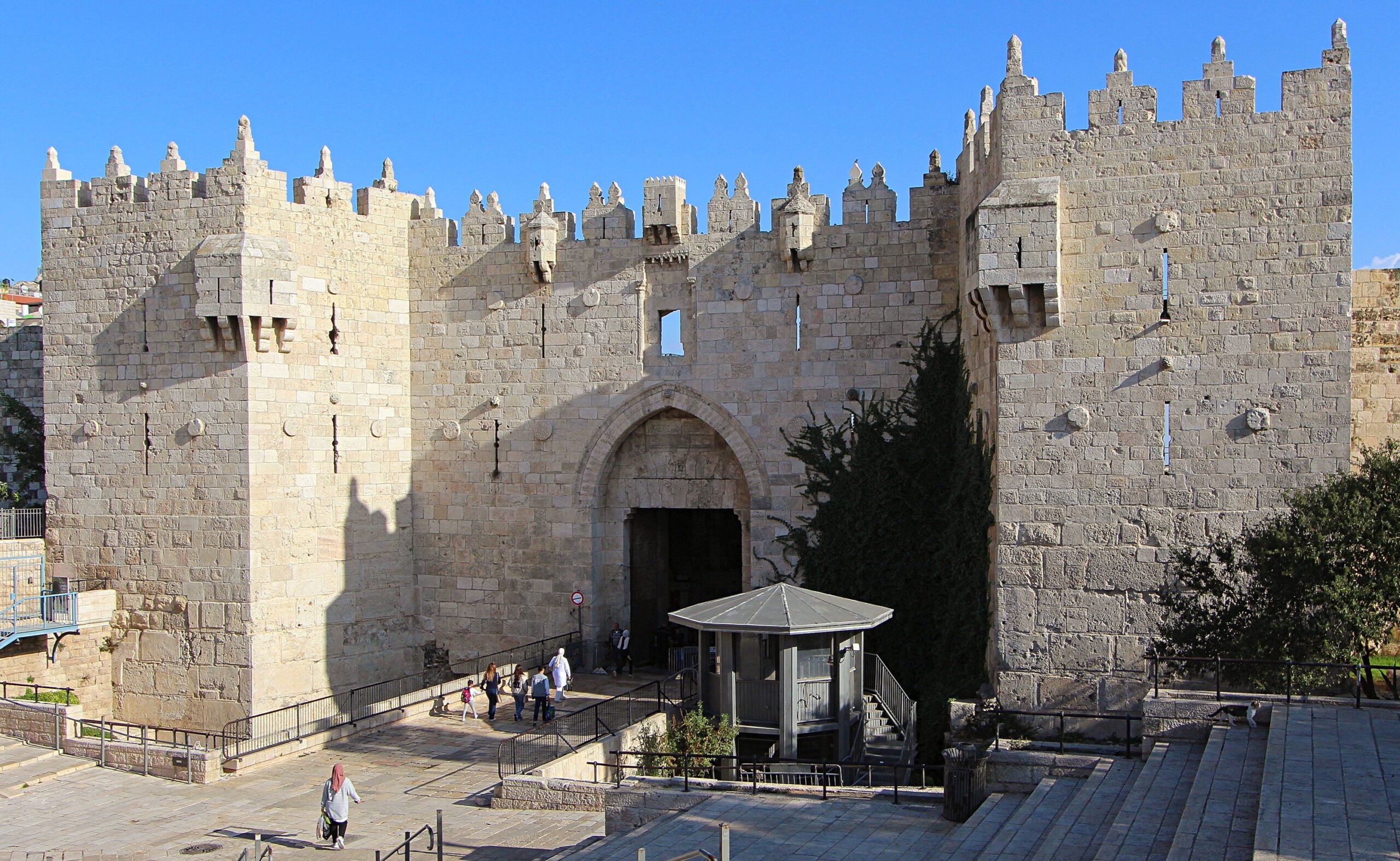
First a brief history of the walls. There are eight gates into the walled city of Jerusalem including one gate that is blocked up. The current city walls were built (in 1538 AD) by Suleiman the Magnificent (1494-1556 AD) and thereafter maintained by the Ottoman Turkish Empire until 1917. The current walls do not completely follow along the lines of the ancient walls of the Old Testament’s City of David, nor the New Testament’s walls that Jesus Christ knew. In 70 AD, the walls of Jerusalem were totally demolished by the Romans. The Roman Emperor Hadrian, in 130 AD built a new city in the Greco-Roman style. The new street plan was completely different from previous Jerusalem cities. But the new city remained without a wall until Emperor Diocletian had one built around 290 AD. In 1033 AD, the walls were mostly destroyed again in a major earthquake and were quickly rebuilt by the Arab Fatimid Kingdom in anticipation of the Crusader invasion. Those rebuilt walls excluded the ancient City of David and Mount Zion (to the south), otherwise they followed the previous Roman foundations. The current walls as rebuilt by Suleiman the Magnificent follow the Roman and Arab Fatimid foundations.
Damascus Gate (a.k.a. Shechem Gate by some Jews, and Gate of the Column by some Arabs). The most famous and often photographed gate of Jerusalem. A few steps outside this gate leads to the Garden Tomb and Golgotha. Inside the gate is a small market plaza where the Roman Emperor Hadrian had set up a pillar/column (now missing). This gate leads to the main shopping district or Suk.

Herod’s Gate. Is also known as the Gate of the Flowers, referring to the rosette stone carving above the gate. It became known as Herod’s Gate in the 1500’s when Christian pilgrims mistakenly identified a large house inside the gate as belonging to Herod, Tetrarch of Galilee (the one who beheaded John the Baptist). The gate leads into the Muslim residential neighborhood.

Lions’ Gate. Is so named because of the four lions that decorate the gate’s facade. Reportedly, Suleiman the Magnificent had them placed on the gate because he had a dream warning that if he did not rebuild the walls of Jerusalem, then he would be eaten by lions. Whether or not it is true, it is a good story. This gate is also called Saint Stephen’s Gate. Tradition holds that the first martyr, Stephen, was stoned outside this gate. But there is no Biblical reference to the actual gate where the martyrdom occurred. Still this is a good place to recount his story.
“When they heard these things, they were cut to the heart, and they gnashed on him with their teeth. But he, being full of the Holy Ghost, looked up steadfastly into heaven, and saw the glory of God,…And said, Behold, I see the heavens opened, and the Son of man standing on the right hand of God. Then they cried out with a loud voice, and stopped their ears, and ran upon him with one accord, And cast him out of the city, and stoned him: and the witnesses laid down their clothes at a young man’s feet, whose name was Saul. And they stoned Stephen, calling upon God, and saying, Lord Jesus, receive my spirit. And he kneeled down, and cried with a loud voice, Lord, lay not this sin to their charge. And when he had said this, he fell asleep.” Acts 7:54-60.
It was through Lion’s Gate that on June 6, 1967, the Israel Defense Forces entered the walled city of Jerusalem liberating the old city from Jordanian occupation. This gate leads directly onto the Via Dolorosa (Christian pilgrimage street). It is through this gate that the Palm Sunday pilgrim’s parade enters the city from the Mount of Olives. A short distance east from the gate is the Garden of Gethsemane.

Golden Gate. This is the walled up gate. It would have lead directly onto the temple mount from the east. An interpretation of the following Old Testament passage indicates that it is through this gate that the Lord will enter Jerusalem at his Second Coming; “Then he brought me back the way of the gate of the outward sanctuary which looketh toward the east; and it was shut. Then said the LORD unto me; This gate shall be shut, it shall not be opened, and no man shall enter in by it; because the LORD, the God of Israel, hath entered in by it, therefore it shall be shut. It is for the prince; the prince, he shall sit in it to eat bread before the LORD; he shall enter by the way of the porch of that gate, and shall go out by the way of the same.” Ezekiel 44:1-3.
A popular Christian tradition claims that Suleiman the Magnificent walled up the gate when he rebuilt the city walls because it was the way the Lord would enter upon his return.

Dung Gate. Is mentioned in Nehemiah 2:13, however, the gate of Nehemiah’s day was located further south at the bottom of the hill (the bottom of the City of David). It is unknown why this gate is called Dung Gate, it is possible that the city trash was emptied through this southern gate into the Hinnom valley. The top of the original arch and rosette built by the Arab Fatimid Kingdom (1540 AD) is still visible, however, the current arch passageway was widened by the Jordanians in 1952. This gate leads directly to the Western Wall, the holiest site in Judaism.

Zion’s Gate. This gate was also built by the Arab Fatimid Kingdom in 1540 AD. It is the closest gate to the Jewish Quarter of the walled city, and it was through this gate that the last defenders of the Jewish Quarter were driven out by the Jordanian army in the 1948 War of Independence. Subsequent attempts to retake the gate by the Israeli forces before the end of the 1948 war are evident by the numerous bullet holes marking the stones around the gate. From 1948 to 1967, this was also the closest point separating the Israeli and Jordanian armies leading to additional bullet marks from hostilities. A few paces from this gate, down Mount Zion, leads to the Tomb of King David, the Upper Room of the Last Supper, the Dormition Basilica, and the Church of Saint Peter in Gallicantu.

Jaffa Gate. A heavily used gate with the best vehicular access. A place where you can always find a taxi. It is named Jaffa/Yafo Gate because the old road leading out of the gate went west down to the port city of Jaffa/Yafo on the Mediterranean. The city wall next to the gate was torn down and a road built to enter the city for the visit of the German Kaiser, Wilhelm II in 1898. This road was the scene for the victory parade of the British General Allenby’s entrance into the city, ‘liberating’ it from the Ottoman Turks during World War I (in 1917).
The Arabic inscription above the gate is a dedication of the building of the walls by the Sultan, Suleiman the Magnificent in the Muslim year 945 (which is 1538 AD). It reads, “In the name of Allah, the merciful and compassionate, our lord the great sultan, monarch of the Byzantines, Arabs and Persians, Suleiman son of Selim Khan, may Allah perpetuate his kingdom, commanded that this blessed wall be constructed in the year 945.”


New Gate. The newest of the gates, hence the name. This gate was added in 1889 to allow easy access for Christian pilgrims. It leads directly into the Christian Quarter of the city and is the closest gate to the Church of the Holy Sepulchre.

< Previous post on Cana of Galilee Where The Lord Performed the First Miracle
Next post on The Tombs of the Virgin Mary >
Return to the Homepage
